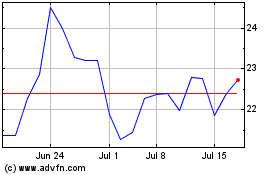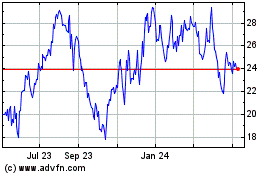Target Scores With Remodeling -- WSJ
May 23 2019 - 3:02AM
Dow Jones News
Improved stores, merchandise and digital services helped lure
shoppers
By Khadeeja Safdar and Allison Prang
This article is being republished as part of our daily
reproduction of WSJ.com articles that also appeared in the U.S.
print edition of The Wall Street Journal (May 23, 2019).
Target Corp. said sales and profit rose at the start of the
year, as improvements to its stores, merchandise and digital
capabilities continued to attract more shoppers.
The retailer on Wednesday reported a 4.8% rise in comparable
sales for the quarter ended May 4. Chief Executive Brian Cornell
said Target's sales and traffic are growing more than the broader
market, resulting in share gains.
Digital sales rose 42% from a year earlier, accounting for
nearly half of overall growth in comparable sales, a measure that
excludes the impact from newly opened or closed stores.
Mr. Cornell credited a strong economy as well as Target's
efforts to improve its supply chain, remodel stores and create new
brands. "We're continuing to see the bifurcation of winners and
losers in retail," he said on a media call Wednesday.
Gross margin declined slightly in the period, which Target
attributed to higher supply-chain and digital-fulfillment expenses.
The Minneapolis-based company has been rolling out web delivery and
pickup services for many of its stores.
Shares of Target, which have gained roughly 9% since the start
of the year, rose 7.8% to $77.54 on Wednesday as the growth in
sales was higher than Wall Street analysts were expecting.
Results from retailers have been mixed so far this year. Walmart
Inc. was among several chains posting stronger-than-expected sales
in the recent quarter, while results from Kohl's Corp. and J.C.
Penney Co. clouded the outlook for the sector. Many retailers are
also bracing for an increase in tariffs on goods imported from
China.
Target, which is a significant importer from China, has
expressed concerns over tariffs. But Mr. Cornell told investors
Wednesday that the company is well-positioned to manage the higher
costs.
"When there are external impacts to one business area or
category, we're able to balance the impact across our business in
ways not available to a single-category retailer," he said.
Earlier this month, the Trump administration imposed a 25%
tariff on $200 billion in Chinese goods, up from a 10% duty put in
place in October. The U.S-China trade fight hasn't hit American
shoppers very hard as major consumer categories, including apparel
and toys, have eluded tariffs so far.
Like other retailers, Target has been spending heavily to adjust
to changes in shopping habits that have made Amazon.com Inc. a
powerful competitor. Walmart also fortified its position as the
country's largest retailer by recently adding to more than four
years of sales increases.
Mr. Cornell has made investments to steer a turnaround at Target
that has included comparable sales gains for the past two years.
The retailer has also been benefiting from store closures by Toys
"R" Us and others.
Some analysts have expressed concerns over Target's spending,
suggesting the retailer could experience more gross-margin pressure
in the long term. In a research note this week, Morgan Stanley said
Target's store-based supply chain "could limit margin improvement
and beget another round of investment in the future."
Target, which has long sought to distinguish itself from Walmart
with fashion, said it launched new brands for intimates, sleepwear
and household essentials and plans to add another label for beach
and pool products. Last weekend, it attracted crowds to many stores
with a limited collection of apparel and home accessories from
preppy brand Vineyard Vines.
"The Vineyard Vines launch is already one of the most successful
in our history," said Mark Tritton, the company's chief
merchandising officer.
Target's first-quarter profit rose 11% from a year earlier to
$795 million, or $1.53 a share. Total sales climbed 5.1% to $17.4
billion.
Target said it expects a low-to-mid-single-digit percentage
increase for comparable sales in the current quarter, and affirmed
its comparable-sales expectations and forecast for earnings for the
full fiscal year.
Write to Khadeeja Safdar at khadeeja.safdar@wsj.com and Allison
Prang at allison.prang@wsj.com
(END) Dow Jones Newswires
May 23, 2019 02:47 ET (06:47 GMT)
Copyright (c) 2019 Dow Jones & Company, Inc.
Kohls (NYSE:KSS)
Historical Stock Chart
From Mar 2024 to Apr 2024

Kohls (NYSE:KSS)
Historical Stock Chart
From Apr 2023 to Apr 2024
